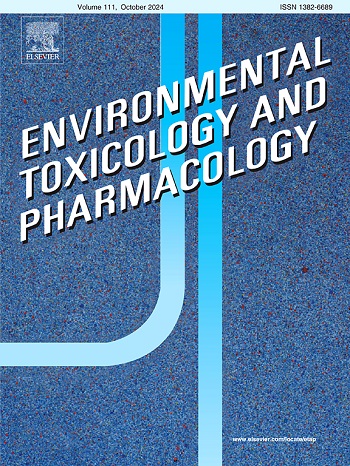Significant metabolic alterations in mouse dams exposed to an environmental mixture of polychlorinated biphenyls (PCBs) during gestation and lactation: Insights into PCB and metabolite profiles
IF 4.2
3区 环境科学与生态学
Q2 ENVIRONMENTAL SCIENCES
引用次数: 0
Abstract
Polychlorinated biphenyls (PCBs) and their metabolites are linked to developmental neurotoxicity, but their levels in the gestational and lactational environment remain unexplored. This study investigated the effects of dietary exposure to the Fox River Mixture (FRM) on serum levels of PCBs and their metabolites in female C57BL/6 J mice. Mice were exposed to 0.1, 1.0, or 6.0 mg/kg body weight/day of FRM beginning two weeks before mating and throughout gestation and lactation. Serum samples collected from the dams at weaning were analyzed using gas chromatograph-tandem mass spectrometry and nontarget liquid chromatography-high resolution mass spectrometry. Results showed complex and dose-dependent differences in PCB and metabolite profiles. Untargeted metabolomics revealed alterations in metabolites involved in glucuronidation. Network analysis suggested disturbances in heme and amino acid metabolism associated with higher chlorinated PCBs. These findings suggested that PCBs and metabolites present in the gestational and lactation environment of mice may contribute to developmental neurotoxicity in rodents.
妊娠期和哺乳期暴露于多氯联苯(PCBs)环境混合物的小鼠母体发生了显著的代谢变化:洞察多氯联苯和代谢物概况。
多氯联苯(PCB)及其代谢物与发育神经毒性有关,但其在妊娠期和哺乳期环境中的水平仍未得到研究。本研究调查了雌性 C57BL/6J 小鼠通过饮食接触福克斯河混合物(FRM)对血清中多氯联苯及其代谢物水平的影响。小鼠在交配前两周开始接触 0.1、1.0 或 6.0 毫克/千克体重/天的 FRM,并在整个妊娠期和哺乳期接触 FRM。利用气相色谱-质谱法和非目标液相色谱-高分辨质谱法对断奶时从母鼠身上采集的血清样本进行了分析。结果表明,多氯联苯和代谢物的分布存在复杂且与剂量相关的差异。非靶向代谢组学显示,参与葡萄糖醛酸化的代谢物发生了变化。网络分析表明,血红素和氨基酸代谢紊乱与氯化多氯联苯含量较高有关。这些研究结果表明,小鼠妊娠期和哺乳期环境中的多氯联苯和代谢物可能会导致啮齿动物的发育神经毒性。
本文章由计算机程序翻译,如有差异,请以英文原文为准。
求助全文
约1分钟内获得全文
求助全文
来源期刊
CiteScore
7.00
自引率
4.70%
发文量
185
审稿时长
34 days
期刊介绍:
Environmental Toxicology and Pharmacology publishes the results of studies concerning toxic and pharmacological effects of (human and veterinary) drugs and of environmental contaminants in animals and man.
Areas of special interest are: molecular mechanisms of toxicity, biotransformation and toxicokinetics (including toxicokinetic modelling), molecular, biochemical and physiological mechanisms explaining differences in sensitivity between species and individuals, the characterisation of pathophysiological models and mechanisms involved in the development of effects and the identification of biological markers that can be used to study exposure and effects in man and animals.
In addition to full length papers, short communications, full-length reviews and mini-reviews, Environmental Toxicology and Pharmacology will publish in depth assessments of special problem areas. The latter publications may exceed the length of a full length paper three to fourfold. A basic requirement is that the assessments are made under the auspices of international groups of leading experts in the fields concerned. The information examined may either consist of data that were already published, or of new data that were obtained within the framework of collaborative research programmes. Provision is also made for the acceptance of minireviews on (classes of) compounds, toxicities or mechanisms, debating recent advances in rapidly developing fields that fall within the scope of the journal.

 求助内容:
求助内容: 应助结果提醒方式:
应助结果提醒方式:


